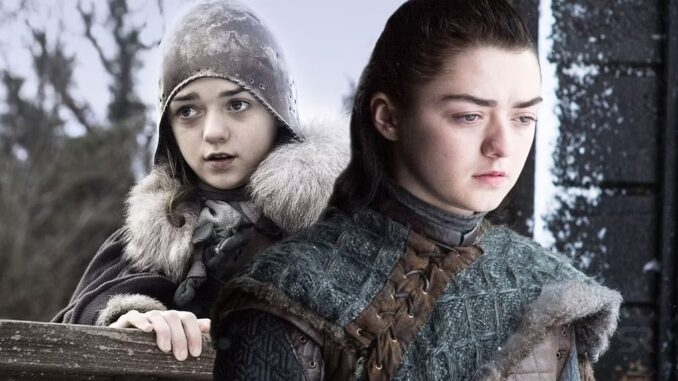
A whole lot has happened throughout Game of Thrones from season 1 to 8 – but how much time has actually passed since the start of season 1?
Working out the Game of Thrones timeline and exactly how much time throughout the eight seasons is a difficult thing to work out with more than a few contradictions. The Game of Thrones franchise continues to grow with countless spinoffs in the works which will explore various time periods in Westeros. In the context of the greater Game of Thrones timeline, the less than ten years in which the original show happened is a mere blip in the thousands of years that comprise the known history of Westeros according to George R.R. Martin’s A Song of Ice and Fire novels.
Despite the relatively short period compared to House of the Dragon which has already spanned decades, the era of Game of Thrones may be one of the most active in Westerosi history with multiple major character deaths, several wars fought and lost over the Iron Throne, the furthest reaches of Westeros and back to Winterfell, and the rise of the White Walkers. With so much to cover, determining how long the Game of Thrones timeline gives a better understanding of some of the show’s biggest moments.
How To Work Out How Much Time Passes In Game Of Thrones
Clues Help To Create A Timeline For The Early Seasons Of Game Of Thrones
It’s estimated that Game of Thrones’ eight seasons occurred across six to seven years — although, exactly how much time passes in the complete Game of Thrones’ timeline is ultimately unclear. Much of the confusion regarding this matter stems from Westeros’ many differences from the real world, such as how seasonal changes work in Game of Thrones, or the lack of recognizable, repeating holidays that could provide more clues about the exact passage of time. In addition, the events aren’t all happening concurrently, and the issues with travel time in this series have been well-documented by angry fans.
…between the pilot and season 2, episode 5, “The Ghost of Harrenhal,” about a year has passed.
However, there are a few comments and details that can be used to put together a rough timeline for the show. In the pilot episode, it is explicitly stated that it has been 17 years since Robert’s Rebellion, while in season 2, it is said that Renly’s death happened 18 years after the Rebellion. This means that between the pilot and season 2, episode 5, “The Ghost of Harrenhal,” about a year has passed.
By season 3’s “The Bear And The Maiden Fair” (season 3, episode 7), another year has passed, as Talisa states that the War of the Five Kings has been going on for two years (and started with the end of the first season). This means that by the end of the third season, somewhere between two and three years have passed.
How The Westeros Calendar Works
The Conquest Of Aegon Marks The Period Of Time In Westeros
The Game of Thrones timeline is much easier to understand when the Westerosi calendar system from the books is taken into consideration, as both shows presumably made no changes to how this works. One year in Westeros lasts roughly the same as in real life, with modern calendar years attached to the acronym AC or Aegon’s Conquest of Westeros, which, according to Aegon I himself, refers to the moment he ended his conquest and was blessed and crowned by the High Septon in Oldtown.
Similar to the Anno Domini system of the Gregorian Calendar, the years before Aegon’s Conquest are marked with BC (before the conquest) with the numbers going backward just like in the real world. Most importantly, the way seasons in Westeros can last for years at a time is basically the only real difference between the passage of time in Game of Thrones and the real world — everything else is roughly the same. Days are 24 hours long, and years are more or less 365 days long.
When The Game Of Thrones Timeline Became Unclear
Sam And Gilly’s Baby Provides A Rare Helpful Clue In The Show’s Final Seasons

Based on contextual clues the Game of Thrones timeline lasts about six to seven years – but from season 4 onward, the chronology seems to get a little murkier. The show doesn’t provide quite so many clear markers as to how much time is passing, and Bran’s time-travel Warging complicates matters. However, there are a handful of mentions of the passage of time to help clear things up.
…three years passed between the middle of season 2 and the middle of season 5
When Jaime heads to Dorne to ‘rescue’ Myrcella Lannister, she says that she has been there for three years. She set out for Sunspear in season 2, episode 6, “The Old Gods And The New,” and sees Jaime Lannister again toward the end of season 5, which means that three years passed between the middle of season 2 and the middle of season 5. This means that by the end of season 5, around 4-5 years have passed in total.
The passage of time in seasons 6 and 7 gets even more unclear, especially as there are no helpful ages given or pregnancies to follow. However, there is one helpful way of measuring time: the growth of Little Sam (Gilly’s baby). Baby Sam was born back in season 3, episode 3, “Walk of Punishment.” By the end of Game of Thrones season 7, he appears to be around four years old, and while this is an estimate rather than stated as fact, that would mean that the series is maintaining around one year of time passing per season and that it has been around six or seven years between the pilot episode and the season 7 finale.
Game Of Thrones Doesn’t Have An Official Timeline (And Doesn’t Need One)
Contradictions To The Timeline Make It Easier To Ignore It Completely
Despite the clues, the information is still speculative, thanks to the fact that there’s no official Game of Thrones timeline. While it makes some sense for the show to have covered around six to seven years in eight seasons, there are some moments that work against the timeline laid out. Sansa gives her age as 13 in season 1, and yet she’s 14 in season 3 when she is married to Tyrion That would suggest that only one year has passed between seasons 1 and 3, directly contradicting Talisa’s statement only an episode earlier that at least three years have passed — as the War of Five Kings had been going on for two.
However, the truth of the matter is that timelines, while interesting, aren’t actually all that necessary in Game of Thrones. This is a fantasy world where seasons last for years, where young teens are wedded and bedded, and where real magic exists. In a world where age and the passage of time is so warped, the lack of a clear timeline actually adds to the strangeness of this universe.
The Game Of Thrones Prequel Happens Centuries Earlier And Covers More Time
House Of The Dragon’s Time Jumps Added To The Extended Timeline
The House of the Dragon season 1 timeline is infamous for its time jumps, which, despite confusing some viewers, were ultimately necessary to cover keystone events in George R. R. Martin’s Fire & Blood. While Game of Thrones covers about six to seven years of time, House of the Dragon covers roughly 27 years from the first to its future seasons, according to Martin. Introducing time jumps to the adapted A Song of Ice and Fire timeline for the first time, the events of episode 3, for example, follow those of episode 2 by three years.
House of the Dragon also covered the years time leading up to the Targaryen Civil War.
This served to make the show unpredictable and adventurous in different ways than its predecessor. House of the Dragon also covered the years time leading up to the Targaryen Civil War (Dance of the Dragons), which occurs in 129 AC. So, while Game of Thrones only goes through about six to seven years, House of the Dragon covers a longer time. It may also delight some audiences to find out that, according to showrunners, House of the Dragon season 2 will no longer feature time jumps in tackling what remains of Fire & Blood.
What Happens After Game Of Thrones
Several Key Game Of Thrones Characters End Up In Positions That Set Up Intriguing Futures
While the various Game of Thrones prequels add more context to the world of Westeros, many fans are curious about what happens after the events of the original series. Despite the show’s penchant for killing people off, several key Game of Thrones characters survived through the whole series and ended up in some interesting positions. Of course, the biggest surprise is that Bran Stark ended up on the Iron Throne with Tyrion Lannister as the Hand of the King. The finale suggested one of Bran’s first orders of business would be locating Drogon who flew away after Daenerys was killed.
Sansa Stark was also seated on a throne at the end of the series, taking her place in Winterfell and being named Queen of the North. Arya Stark went off on her own adventure to explore whatever was west of Westeros. As intriguing as these next chapters in their stories are, George R. R. Martin has not written about the events following Game of Thrones so it is all speculative what becomes of these characters. Some of the upcoming Game of Thrones spin-offs had a chance to provide answers but most are prequels including Aegon’s Conquest, while the planned Jon Show sequel series has been shelved for the time being.
